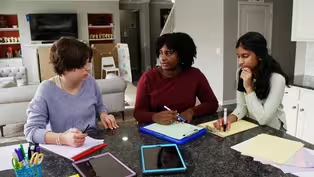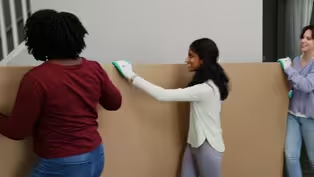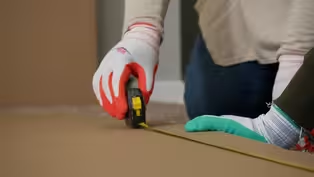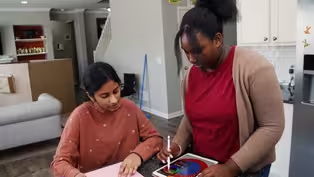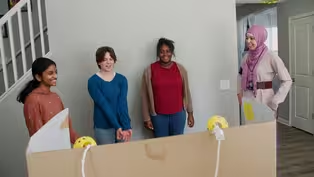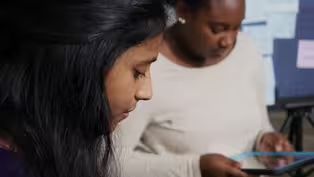SciGirls
SciGirls in Space: Making Space
Special | 28m 46sVideo has Closed Captions
SciGirls are on a mission to reduce harmful effects of isolation during deep spaceflight.
Amaya, Lily, and Nikki launch an investigation into the hazards of deep spaceflight, starting with a planetarium film that takes them on a virtual voyage to Mars. On a mission to reduce the harmful effects of isolation, the girls draw on their personal experiences during the COVID-19 pandemic and create a solution that promotes wellness in space and on earth.
Problems playing video? | Closed Captioning Feedback
Problems playing video? | Closed Captioning Feedback
SciGirls is a local public television program presented by TPT
SciGirls
SciGirls in Space: Making Space
Special | 28m 46sVideo has Closed Captions
Amaya, Lily, and Nikki launch an investigation into the hazards of deep spaceflight, starting with a planetarium film that takes them on a virtual voyage to Mars. On a mission to reduce the harmful effects of isolation, the girls draw on their personal experiences during the COVID-19 pandemic and create a solution that promotes wellness in space and on earth.
Problems playing video? | Closed Captioning Feedback
How to Watch SciGirls
SciGirls is available to stream on pbs.org and the free PBS App, available on iPhone, Apple TV, Android TV, Android smartphones, Amazon Fire TV, Amazon Fire Tablet, Roku, Samsung Smart TV, and Vizio.
Providing Support for PBS.org
Learn Moreabout PBS online sponsorshipMore from This Collection
A collection of SciGirls STEM adventures with a focus on human spaceflight, traditional star knowledge, astronomy, materials science, Earth science and using sensor technology. Across two new and four previous episodes, smart, creative and inspiring real girls team up with adult STEM professional role models to use STEM to solve problems, help people and have fun!
SciGirls in Space: Dakota Stars
Video has Closed Captions
Indigenous SciGirls learn how modern science connects to ancestral Dakota star knowledge. (28m 46s)
Providing Support for PBS.org
Learn Moreabout PBS online sponsorship- NASA's planning on sending astronauts back to the moon that will lead the next generation onto Mars.
- To accomplish that, there needs to be new solutions to new problems.
- We're gonna focus on isolation.
(person) I like how cozy our design is.
- High five.
- [laughs] [upbeat music] (announcer) Funding for "SciGirls" is made possible by NASA.
NASA inspires the future generation of space explorers and scientists to engage in the science, technology, engineering, and math that is the foundation of NASA's mission success.
Additional funding is provided by: PPG Foundation aims to bring color and brightness to communities around the world.
♪ ♪ (girls) ♪ S-C-I-G-I-R-L-S ♪ (Izzie) We need you!
(girls) ♪ S-C-I-G-I-R-L-S ♪ (Izzie) Come on!
(girls) ♪ When I need help and I've got a question ♪ ♪ There's a place I go for inspiration ♪ ♪ Got to get to the web, check the girls' investigation ♪ ♪ What girls?
♪ ♪ SciGirls!
♪ Whoo!
(girls) ♪ S-C-I-G-I-R-L-S ♪ (Izzie) I need you!
(girls) ♪ S-C-I-G-I-R-L-S ♪ Come on!
♪ You've got to log on, post ♪ ♪ Upload, pitch in ♪ Yeah!
♪ Want to get inside a world that's fascinating?
♪ ♪ The time is right 'cause SciGirls are waiting ♪ (girls) ♪ S-C-I-G-I-R-L-S ♪ (Izzie) We need you!
(girls) ♪ S-C-I-G-I-R-L-S ♪ (Izzie) SciGirls!
Hola!
I'm Izzie, and this is where I live.
This is my room.
I love animals, reading, cooking, and spending time with my family.
And my very favorite hobbies are soccer, exploring, and building things.
My parents and I hope I'll become a scientist or engineer one day.
And look at this.
More girls who like the same stuff I do.
Science and engineering is for you.
Come on.
I know you can do it.
♪ ♪ - Got to put my mask on.
- I'm so excited to explore the Bell Museum.
♪ ♪ - Today's the day.
♪ ♪ - We're at the Bell Museum to learn about our project and what we're trying to figure out.
[laughs] That made me flinch.
- My name is Nikki.
I'm from India, and I like to read a lot.
And my favorite subject in STEM is probably biology and science.
- Oh, wow.
My name is Lily.
I'm an outdoor, active person.
I'm interested by, like, chemistry and also space and stuff.
Like, there's other life out there too.
(automated voice) Start dancing.
Bow.
- My name is Amaya.
I like to be creative, I like to go with the flow, and I like botany with, like, plants and stuff.
(automated voice) Jump.
Great job.
- There you go.
I haven't worked with this team before, so it's all very brand-new.
- I met Nikki before, but we haven't worked together.
- I have no idea what the project is yet, but I'm excited to find out what it is.
- Hi, ladies.
How are you?
(all) Good.
- My name is Nadia.
I'm a NASA Solar System Ambassador.
- A Solar System Ambassador educates kids on space travels and experiments.
- You guys come from different backgrounds and you guys have never worked together, so this is a really good example of just how NASA is reaching out to bring different perspectives into challenges.
- Having a wide variety of perspectives in the team is very important because it contributes new ideas to a solution.
- In the next decade, NASA's planning on sending astronauts and humans back to the moon, but also, eventually, that will lead the next generation onto Mars.
- Going from the moon to Mars is a big deal because it's very far away.
- And to accomplish that, there needs to be new solutions to new problems.
- So your mission is to basically investigate long-term space exploration and the hazards that come with that.
We'll get you started.
You'll speak with Sally, and we'll catch up later.
- Awesome.
- Cool.
(Lily) Nadia suggested that we would meet with sally and learn about the different hazards of space flight and going to Mars.
Oh, wow.
- It's so big.
- Whoa.
- Wow.
- Hi.
Welcome to the planetarium.
It's so good to have you.
I'm Sally.
(Amaya) Sally is an educator at the Bell Museum.
- Today you're going to see a preview of a new show that the Bell Museum is producing.
It's called "Mars: The Ultimate Voyage."
- Sally's creating a planetarium film about the space hazards of going to Mars.
- All right, so let's go have a seat.
- The difference between a planetarium film and a regular film is that the planetarium film shows you different perspectives and, like, views.
- The screen isn't flat, so it's, like, a dome.
And it feels almost, like, 3D.
- It's still moving closer.
[laughter] (Nikki) It's, like, immersing you in the travel to Mars and all the different problems that arise while going there.
- So these are the challenges you want to be paying attention to.
(Nikki) There's an acronym for the space hazards and it's called RIDGE.
The R stands for radiation.
The I is for isolation.
D is for distance.
The G stands for the lack of gravity in space.
E is for hostile environment.
Gosh.
- Oh, dang.
[applause] - The film was really cool and it made me feel like I was moving with the film.
(Nikki) I got, like, a little bit nauseous when I was seeing all the stars move.
(Lily) It made me want to find out more about the different hazards of space that they went over.
- Do any of those sound familiar, like, something that's not just happening in space, but might happen down here on Earth?
- Yeah, like the isolation.
During COVID, like, you couldn't go anywhere and see anyone.
But it's similar, but it's still different.
- So yeah, some of the challenges aren't really just for astronauts out in space, but they're important ones to solve sometimes for people here on Earth.
In a couple weeks we're gonna have a screening of this planetarium show, and for that, you're gonna work on one of these challenges that you think you might have some solutions to.
- We're gonna focus on isolation and coming up with solutions.
- It relates a lot to what we've been through for the past two years in the COVID-19 pandemic where we were all in isolation.
- We are going to present our project at a screening of the planetarium at the museum.
(all) One, two, three, Mars.
- Hello.
I'm Nikki, and I'm gonna show you what I like to do.
I play volleyball.
Here I'm gonna show you how I serve.
[whistle blows] So today for lunch I made puri, which is like fried bread.
And I made a mixed vegetable curry.
Here it is.
Mmm, this is really good.
Mm, I'd probably rate it a eight out of ten.
I like to play violin.
This is the D major scale.
[playing violin] ♪ ♪ Thanks for listening.
[applause] - Today we're at Nikki's house to brainstorm a little bit about, like, what we know about social isolation.
- What are some, like, problems that you guys have, like, had with, like, isolation?
- The lack of change.
- Yeah.
- Like everything's the exact same, like, every day.
- Just, like, being stuck in the same, like, routine.
- I think it would be beneficial to us to go on the internet and see what NASA has done so far about these unknowns.
(Amaya) So we started researching what's known about isolation and then we also kind of looked into what is unknown about isolation.
- So I found this really cool website that NASA uses to put down, like, analog missions.
- An analog is basically like just a test run.
- This one site that I found is an analog mission where it focuses on the hazard of isolation called HERA, Human Exploration Research Analog.
(Lily) Maybe we can talk with one of the HERA researchers and see what they found out about effects of isolation.
- I think that's a great idea.
- Yeah.
We are meeting Dr. Kim Seaton.
She is a psychologist at NASA.
- Hi.
It's so great to see you.
- We've been looking into the HERA mission, so could you tell us a little bit more about that?
(Kim) Excellent.
Sure.
We have a crew.
Right now they are on mission day 8 today of 45 days.
So they are living and working inside that habitat on Johnson Space Center.
- What do you think are some key points that we should focus on?
- HERA, the habitat, is very cozy.
It's kind of like a studio apartment.
One bedroom, one bathroom.
Very small.
And when you think about a spacecraft like that, there's very little privacy.
So the HERA crews, they have their individual crew quarters and it's kind of like a little one-person tent, but there's no privacy.
There's no interior walls separating them and so if someone snores, they're gonna hear it.
- It really does pose a problem of how four crew members usually, they don't have any privacy and they're basically all open.
- Sleep deprivation, that's a big one.
On the ISS, they're orbiting the Earth, so they see sunrises and sunsets about every 40 minutes.
So that can be very disruptive to the circadian rhythms.
- So while I was doing some research, I came across the fact that astronauts use journals.
Can you explain a little bit more on that?
- Oh, that was a great find.
Yeah, similar to other explorers throughout history, astronauts, many of them have enjoyed journaling.
It's a way to reflect and learn from their experience.
And it's also--it's-- it give the researchers a tool to monitor behavior, see their thoughts.
- So when can we check back with you?
- How about we meet again in a couple of weeks?
- That sounds great.
Thank you so much.
(all) Thank you.
- Thank you, girls.
Bye-bye.
(all) Bye.
- Hi.
My name is Lily and one of my hobbies is playing my guitar.
[playing guitar] ♪ ♪ [cheering] Another one of my hobbies is soccer.
Hello.
Another thing that I like to do is read books.
Another hobby I like to do is photo editing.
Let's talk about what we learned.
- Yeah, we can go for some solutions.
- The lack of privacy in the spaceship, since it's so small.
I had an idea that you could put curtains up.
- Maybe curtains and, like, noise machines.
You know, at REC centers they have, like, different rooms dedicated to different things.
- What if there's, like, a little, small space, like, a mini booth and you can just go in there and be by yourself.
Like, maybe there's, like, some noise-canceling headphones in there.
- Yeah.
- I think, also, changing the lighting.
Like, having fairy lights.
- Yeah.
- We're doing something called a wellness booth, which combines the problem of privacy, mental health, and just happiness in general.
- When we're using the space, maybe, like, we can film part of it and just basically, like, talk about what we're doing and, like, reflect on it, you know?
And then we can come back and share it.
(Amaya) So our next step is we're going to make prototypes out of, like, cardboard boxes.
- You have to do a little bit of math here: 8 feet into thirds.
- Yeah.
- How many inches is 8 feet?
- 96.
- One wall size is 32 inches long.
- That looks right.
And then the other side.
- Yeah, we have to do the same thing.
Like that.
So it's a confined space just for you.
- Good job.
- All right, let's fold.
(Amaya) We're each gonna take one home and do little, like, video diaries.
And then we can make this one like this.
(Lily) Our goal is to spend, like, 15 to 30 minutes in there each day.
And we're, like, gonna customize it to our needs and, like, what we want in there.
- I think that'll help us in the next phase by mimicking what the astronauts would do.
(Amaya) I'm excited to, like, tell my sister to leave me alone and to, like, give me some privacy.
- Yay.
- This was actually... - There we go.
- This was a good one.
- Yeah.
- Yeah.
- Day one of the Angle 1 mission.
- I remember when I was sitting in there.
It was really small.
- After reading for 25 minutes, I just felt more relaxed in here.
- Today, I decorated the booth a little.
- it was really fun, like, just to be down there and just kind of doing whatever.
- Today, I didn't really do much, but I did take a really good 30-minute nap.
- Today, I'm going to be doing some homework.
- Not much changed except I went from, like, a ton of energy to a little energy.
- It's feeling really cramped in here.
It's kind of, like, small, but I think I'm gonna take a nap in here today.
- Now, I just played my ukulele, and it was really nice, actually, 'cause I just sort of got to, like, reset and rewind.
♪ ♪ - This is my prototype.
- Oh, wow.
(Lily) Today, we're at Nikki's house and we are going to be discussing our different booths.
And then combining our ideas into the final prototype.
- Did you feel like you had, like, enough space?
- Yeah, you know, I could, like, stretch out my legs a little bit and sit around comfortably.
I think my mood changed after I used the booth.
Like, I just felt more, like, calm and relaxed.
- So this is what mine looked like.
I just wrote on the walls mostly one day.
- Oh, I like the idea of, like, putting quotes down.
- Mm-hmm, or just having, like, conversations on the wall.
- Yeah.
- Yeah.
- I drew, I wrote, I read, I played my ukulele, and I knitted.
- So here's my space.
Kind of decorated it with some, like, washi tape.
I sat on the floor with a pillow and then I just kind of filled it with things, like, books or blankets or stuffed animals.
- What was one of the things that didn't really work that well in the booth?
- I guess, like, just kind of, like, stretching.
- Mm, yeah.
Like, there wasn't a ton of space.
Yeah.
- Yeah.
- We wanted our size to be more inclusive 'cause the prototypes that we made are just for, like, us.
You know, like, 13-, 14-year-olds.
- The cardboard prototype we have, the wall--one wall size is 32 inches long.
Should we raise it to 3 or 4 feet?
- Maybe, like, 4 feet?
- Yeah.
- Not too much longer because there's not a lot of room.
- We just sort of, like, bounced ideas off of each other and I don't think we had any, like, big, major disagreements.
We're just sort of, like, going with the flow and I feel like we all worked together.
- Maybe wall number two could be, like, the picture wall.
- Mm-hmm.
Maybe spaces to write on the wall if you want to.
We decided to use a fold-down desk and using a virtual window for different, like, backgrounds depending on what kind of mood you're in.
- Since we might have, like, a desk, we should have a chair.
- Yeah.
(Nikki) I think they're great teammates to work with.
They're very open-minded.
- Working with Lily and Nikki so far has been great.
We make a good team and, you know, teamwork makes the dream work, so... - It looks great.
- Yeah.
- So now, we're ready to start building.
- All right, let's go.
- Yeah.
♪ ♪ - Suspenseful music.
[laughter] ♪ ♪ (Lily) The entire thing's gonna be made out of cardboard, but to keep it together, we're gonna have Velcro and these little screws that we can put in.
And then we can take them back out too, so we can reassemble it later.
It's trying to pull at this, like, edge right here.
The most challenging part, I think, is figuring out how to do it with cardboard.
- Cardboard isn't really like wood.
Like, you can't just, like, screw it and be done with it.
You actually have to think about how you should position it.
These little curvy thingies in the middle of the cardboard, that's the corrugated part of it.
If it's vertical, it will be stronger than if it's horizontal 'cause then it will fold.
(Lily) Cardboard can be your worst enemy or your best friend.
[chuckles] It's like, it's sturdier than paper, but when you're really trying to, like, build it and it bends where you didn't want it to bend, that can be very frustrating.
But we're figuring out how to make it work.
There, it's like a little door.
See?
Ta-da!
- I think the most fun part is constructing it and then seeing what'll happen at the end.
- All right.
- So now do you guys want to put the roof on?
- Yeah.
- Sure.
- Hey.
- Hey.
[laughter] - It's bending.
- Yeah.
- We're gonna need to figure out, after we screw them in, how to deal with that.
- Yeah.
- Yeah.
- That's pretty good.
- Yeah.
- It looks like a house.
- Yeah.
- It is a house.
- We did good, you guys.
- Yeah.
- Yeah.
- High five.
[laughter] - Tri-five.
- Tri-five.
- Tri-five.
- Hey, guys.
It's Amaya.
I'm here at the lookout on the High Bridge.
I really enjoy walking across the High Bridge in the summer and heading downtown.
I'm here with my mom.
We're running some weekend errands.
I really enjoy spending some time with my mom and hanging out with her.
She's, like, my best friend/mom.
This is my best friend, Charlotte.
We're both in Girl Scouts.
- Hi.
- My mom is our Girl Scout leader.
I've been in Girl Scouts since I was five.
One of the traditions in my household is celebrating Galentine's Day.
We eat treats and have lots of laughs.
I'm here with my sister.
- Hello.
- And we're both in Girl Scouts and we're about to go deliver some cookies.
I'll see you guys later.
- Oh, sorry.
- Like, bending a lot.
- It is.
- Today, we're working on getting our booth finalized.
(Lily) And we're also gonna see Nadia and she's gonna give us some feedback.
- So first, we kind of, like, made the desk part.
- It's gonna be like that.
Wasn't it?
- In our plans we said we were gonna have, like, these triangles held into the wall.
And then we made it so that it would fold upward.
- All right, how does that look?
- It looks good.
- How does it feel?
- It feels good.
I feel like I have enough leg room underneath.
It's a little flimsy.
- Maybe we should add three total.
One in the middle and then two on the sides.
- Yeah.
- I am very impressed that we were able to pull that off.
- Come on this way.
Today, was kind of like a check-in with Nadia to see how we're doing with our design.
- What we created was a wellness booth, so this was the first prototype.
- Is that what the smiley faces are for?
To make you feel happy and... - Yeah.
- Okay, okay.
I like it.
- And in our new prototype... - So you kind of want to try it out?
- Sure.
Yeah.
- We will fix the roof.
We promise.
- Yeah.
- Okay.
All right, great, so this will definitely accommodate my height.
(Amaya) It was, like, really nice to, like, get somebody's new perspective on it.
- There's gonna be, like, a virtual window.
- Okay.
- 'Cause when you're in space, you only see space.
- Right.
- So you miss stuff on Earth, so if you want to, like, set it to different backgrounds and stuff.
- And we're also thinking about getting a diffuser to, like... - To stimulate, like... - Smells--the smells and stuff.
- Very cool.
That would be nice.
So you guys want to activate the five senses, right?
- Yeah.
- That's definitely very important for us.
Have you guys thought about the situation with gravity?
As you know, astronauts are experiencing micro-gravity, so how will I be able to sit down on this chair, relaxed?
(Nikki) Nadia told us that we should be more aware of how gravity can affect our booth and how we should accommodate for it.
- So I love this table, but I do-- but I did notice that the edges of it, you know, rough.
(Lily) To have Nadia be able to look at our progress that we made so far, it was really-- it was nice to see, like, sort of how far we've come.
- Okay, so I know you guys have a few more things to add, and I don't want to throw more things to add, but I think that it would be a great idea to put together a mission patch.
The fun thing about NASA is that they put together mission patches for all of their missions.
And the even cooler thing is that usually the crew members design their own mission patch.
- A NASA mission patch shows that you're part of a NASA mission and it shows what kind of mission you're on.
- So you guys can design that and your museum visitors will be able to see that in an artistic way.
- Yeah.
- All right, cool.
I'm excited to see it.
♪ ♪ - There you go.
- Like, right here?
- Yeah, that looks good.
♪ ♪ - Will the lights work?
- A little more down.
Whoa, when were they?
[laughter] - We're just seeing how dark it would be.
- Ooh.
- Ooh.
(all) Ah.
[laughter] (Amaya) I like how cozy our design is.
- It feels like a home.
Like a mini home.
- Like, for the outer circle, maybe it should have, like, hazards of deep space.
(Lily) When we were designing our mission patch, we were thinking about what words we wanted to incorporate that sort of summed up what we were trying to do.
Should we maybe write "wellness"?
- Or, like, what if we, like, wrote, like, "wellness everywhere"?
- Yeah.
- Okay, guys, here's the design.
- Oh, I like it.
- I do too.
We'll use our mission patch to show everyone that we're part of this mission when we're presenting our project to everyone.
- Today, we are working on finalizing the booth.
- And also to ask Dr. Seaton for, like, tips on how to improve.
- Okay.
Amaya, can you push against it?
- Yeah.
- Okay, it looks good.
- Okay.
- So in our new roof design, first, we changed the direction of the corrugation because we noticed that the roof was folding a lot.
- Righty tighty, lefty loosey.
- Yup.
Oh, wait.
I was turning it the wrong way.
[chuckles] We put some quotes on the wall, too, next to the window, which we also finished.
- I like this quote where it's, "You can do hard things."
- Mm-hmm.
- Because that's just empowering.
Although there were some problems, like, while building it, I never really felt that stressed, 'cause all of my teammates and me, we were in this together.
- They look like stars.
- They do, yeah.
- Right here.
- Today, we are meeting Dr. Kim Seaton to get a little bit more feedback.
- Hi.
- Hi.
It's so great to see you again.
- So we're here in our wellness booth.
- All right, well, I'm excited to see what you've been up to.
Can you walk me through it?
- Here we have a seatbelt and so when you are sitting at the desk, you don't want to be floating around.
- Nice.
I love that.
- It felt really good to share our project with Dr. Seaton, because she works with astronauts, and she kind of knows what they need.
(Nikki) It felt very rewarding because we spent a lot of time on this.
- I am so impressed with what y'all have put together.
You're gonna inspire people to hopefully take better care of themselves.
- Thank you so much for meeting with us.
- Yeah, we really appreciate it.
- Yeah, thank you.
We'll definitely send you pictures of our presentation.
- Best of luck with your presentation at the museum.
(all) Thank you.
(all) Bye.
- Does this look good?
- Yeah.
(Nikki) I feel pretty relieved now 'cause now I don't have to really do anything.
Except I just have to present to the guests in the Bell Museum, which now I can look forward to.
- I think we're ready.
I think it's gonna be really fun to show people what we've worked on, and I hope they like it.
- Come on in.
- Hello.
(Amaya) Some of the activities that are a part of today is a special screening of "Mars: The Ultimate Voyage" as well as we are getting feedback on our wellness booth.
(Nikki) We're taking some of their feedback on how to cope with isolation and putting them all on our wellness board.
(Lily) We will have them make their own mission patch like the ones we have right here.
- We were researching about the hazards of deep space.
- We were thinking of some solutions and ways to kind of cope with isolation, and that's where the wellness booth idea came in.
- It says, "hazards of space flight" 'cause that was the problem we were focusing on.
And then "wellness everywhere" is the solution 'cause we want the astronauts to be well.
Here are some stickers of our mission patches.
- Thank you.
- Mm-hmm.
You're welcome.
(Nikki) I hope that people learn that they can make something as simple as a cardboard contraption to help with space exploration and that it's not just astronauts working to go to space.
It's, like, so many different types of people can be in NASA.
Right behind you, there's a desk that folds down.
- That's cool.
- Yeah.
- Most of the guests today said they really liked it.
- It did make me feel, like, relaxed and calm.
- It can help people on Earth, too, with mental health, and we see how the pandemic has effected people as well, which is why I think the project is so valuable.
- I think this is awesome.
You guys did an amazing job, and I'm proud of you.
- The astronauts on our trip to Mars would be lucky to have such great things to help them take a break.
- You guys should be so proud of yourselves.
(Lily) Even though our project was specific, I think it's important to practice wellness wherever you are.
(Amaya) We've only just begun the research, so there's so much more that can be explored and discovered.
- Wellness everywhere.
- It's super cool.
- Maybe when I grow up, I'll probably work for NASA.
- We should take a photo to send to Kim Seaton.
- Oh, yeah.
- Yeah.
[camera shutter clicks] (girls) ♪ S-C-I-G-I-R-L-S ♪ - It feels great to look at the stars in a place my ancestors did.
- Welcome to our star party.
(person) Say hi to the sky!
(person) Hi!
- Hold out a circle with your arms, and that's your circle of observation.
(Lily) We're gonna focus on isolation.
(Amaya) I like how cozy our design is.
[all speaking Spanish] [cheering] - Would you girls call that a success?
(all) Yeah.
(person) We're like NASA girls!
- Whoo!
- We're NASciGirls.
♪ ♪ (Izzie) Funding for "SciGirls" is made possible by NASA.
NASA inspires the future generation of space explorers and scientists to engage in the science, technology, engineering, and math that is the foundation of NASA's mission success.
Additional funding is provided by: PPG Foundation aims to bring color and brightness to communities around the world.
♪ ♪ (girls) ♪ S-C-I-G-I-R-L-S ♪
Video has Closed Captions
Clip: Special | 1m 39s | The SciGirls compare their designs then combine the best elements into a team prototype. (1m 39s)
Video has Closed Captions
Clip: Special | 1m 53s | After discussing their design, the SciGirls get to work building their prototype. (1m 53s)
Video has Closed Captions
Clip: Special | 56s | The SciGirls start to make prototypes out of cardboard. (56s)
Video has Closed Captions
Clip: Special | 29s | The SciGirls design a mission patch to sum up and convey what they have accomplished. (29s)
Video has Closed Captions
Clip: Special | 1m 22s | The SciGirls check in with their mentor, Nadia, for feedback on their design. (1m 22s)
Video has Closed Captions
Clip: Special | 2m 42s | The SciGirls take to the web to find all the known and unknown effects of isolation. (2m 42s)
Providing Support for PBS.org
Learn Moreabout PBS online sponsorship
- Science and Nature

Capturing the splendor of the natural world, from the African plains to the Antarctic ice.

- Science and Nature

Explore scientific discoveries on television's most acclaimed science documentary series.












Support for PBS provided by:
SciGirls is a local public television program presented by TPT

